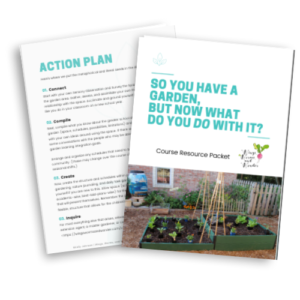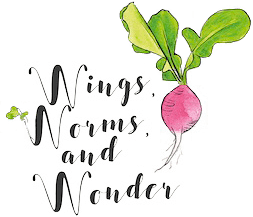School Gardening with Trillium Montessori!
School Gardens: Integrating Gardening Throughout the Elementary Curriculum
In 2004, during lunch in my classroom, I was hit with a tomato. Not literally, fortunately, but metaphorically. It was a day like any other, lunch was going normally and nothing particularly noteworthy or groundbreaking was happening. So I’m not sure why one student’s lunchbox container of cherry tomatoes hit me like it did that day. Perhaps it was the contrast of other lunchbox contents or perhaps it just prompted the memory of my grandfather’s garden tomatoes.
For the first half of my life, I had grandparents who grew much of my food. Childhood summer mornings were spent “helping” Grandpa care for his garden and it was a rare dinner that didn’t incorporate at least one ingredient grown by a relative. Honestly, it wasn’t until after college that the lightbulb went off that not everyone’s grandpa grew their vegetables. It sounds silly, but it was just something I never thought about because the veggies and gardens and canned goodies were just always around.
Back on that pivotal tomato day in my classroom my own grandfather was still alive, and still growing tomatoes, so the thought of his tomatoes wasn’t particularly nostalgic. But what was nostalgic at the time was the memory of how I used to “help” him grow tomatoes, and the sudden realization that the tomatoes in that lunchbox weren’t grown especially for that child by their own grandfather. It was that moment I knew exactly what I needed to do. I must teach my students to grow tomatoes. I must be their tomato growing surrogate grandfather. And so my school gardening journey began!

So you have a garden, but now what do you do with it?:
This is a very common conundrum in the world of school gardening. It’s easy to build a garden, but maintaining it so it thrives is really where the work comes in — but in the same way the children approach work as enjoyment in the indoor environment, gardening in our outdoor environment is fun and very worth the effort.
In my years as a Montessori elementary classroom teacher in a small beachside community, after the tomato moment, I noticed a pattern in students, and adults, regarding their relationships with food, gardening, and nature. Lunch box contents and repeated evidence of the students’ lack of “green time” at home, plus my colleagues’ simultaneous attraction to and fear of the outdoor environments and our garden, further inspired me to take action in my classroom integrating gardening across our curriculum.
I focused more of our activities outdoors, we cooked and ate more from the small garden we built together from a Farm Bureau grant, & we centered field trips around local farm visits, nature centers, and state parks. I scheduled more nature journaling opportunities into lesson plans, and was thankful for the Montessori elementary curriculum’s emphasis on natural history, economic geography, botany, and zoology research.
The discovery learning inside the classroom anchored and contextualized our outdoor garden experiences into cosmic education. After a few years, when evidence of the garden integration’s many benefits became apparent to the wider school and parent community, a revolving door of colleagues and parents came to me, often quite panicky, with gardening questions like: “Can I bring my class to walk around your garden? What’s eating my tomatoes? What am I supposed to do with this new garden bed the PTA wants me to incorporate into my packed schedule, and even “My daughter wants a vegetable garden like the one at school for her birthday, Help!” To that parent I responded, “First, let’s be thrilled your child wants vegetables for their birthday!” To the others I said, “Yes, together we’ve got this! Let’s get your class gardening!”
And fortunately, 20 years later, the questions have kept coming. People everywhere are even more interested in connecting their families and students to local environments and foods through gardening!
The Solution:
Over my past 2 decades of gardening with children in academic and community settings, the root of most adults’ worry seems to stem from their perceived lack of “green thumbs”. The adults fear their inexperience will ruin the children’s experiences in the garden. I remind them that where much of the magic happens is in Montessori’s endorsement of adults to honestly tell children, “I don’t know, how could we find out?” And that this rings just as true in children’s gardening as in the Montessori classroom!
If you can’t imagine seven–year–olds being beyond excited to eat raw kale, grow some at school and watch what happens!
The wonder involved in a child’s connection to their food has proven many a parent adamant that their child won’t eat vegetables, very wrong. When children grow it, they eat it. Modern children are hungry for connection to the land and the empowerment brought from growing their own food.
As Montessori educators we know the positive impact that experiencing nature, learning to be good stewards of our Earth, and maintaining a school garden can have on our students. The influence is far reaching and can last a lifetime.
But for many of us that is easier said than done! The lack of gardening know-how and feelings of overwhelm can stop us in our tracks.
While all of our outdoor spaces are going to look different – from a few pots on a patio to a small farm (and everything in between) – what matters is that we start where we are and keep the Montessori Elementary classroom specifically in mind!
Think of me & this course as your personal garden gnome, ready with a map to help guide your school gardening journey. It doesn’t matter whether you have a small farm or a collection of flowerpots on a patio, or whether you’ve been gardening with grandpa your whole life or ate your first tomato yesterday.
My aim is to offer you tried, true, and practical tips, tricks, methods, and ideas straight out of my own Montessori elementary classroom to cultivate confidence to engage your students with gardening and outdoor learning. And I promise I won’t throw any tomatoes at you in the process! In this course we won’t approach how to build a garden, but rather what TO DO with a garden.
In the course, we cultivate topics such as:
- How to set yourself up for success, how to avoid overwhelm, and how to build that green thumb confidence. And what does Maria Montessori have to say on the topic anyway?
- Practical hands in the dirt know how, maintenance success, and safety.
- How to access local resources for your location’s specifics. From when to plant what to how to understand soil and microclimates.
- How to let the garden work for you by integrating gardening across the Montessori elementary curriculum with practical on the shelf integration examples, plus extension lessons that weave seamlessly into the cosmic curriculum.
- Systemic biases towards outdoor education and how to overcome them
- The alignment between Dr. Montessori’s philosophy on children gardening and what current research tells us
- The practicalities of how to maintain a school garden and facilitate learning in a school garden setting
I won’t say all of your tomatoes will make it to the table, but I will say you’ll go forth on your school gardening journey with confidence and the seed knowledge to create school gardening experiences that integrate across existing Montessori curricula lessons, and inspire you and your students by provoking observation, curiosity, and wonder.
Which Wings, Worms, and Wonder + Trillium Montessori Course is right for you?
Share in the comments below!
If you’ve taken one of them, share which course & your favorite part!
Seeds to Sprout:
Click here to Learn more and Register for the School Gardens eCourse with Trillium Montessori!
